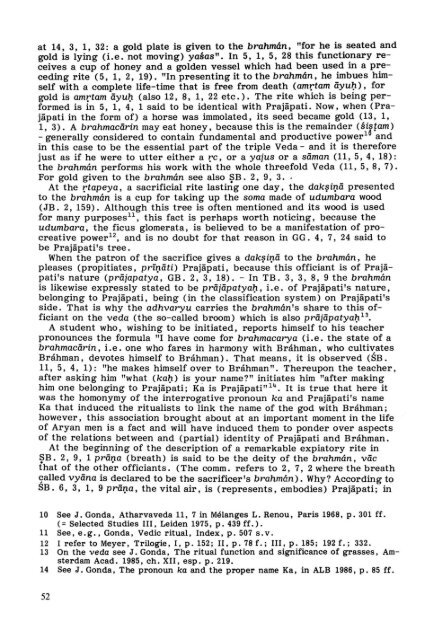Prajapati's relations with Brahman, Brhaspati and Brahma - DWC
Prajapati's relations with Brahman, Brhaspati and Brahma - DWC
Prajapati's relations with Brahman, Brhaspati and Brahma - DWC
Create successful ePaper yourself
Turn your PDF publications into a flip-book with our unique Google optimized e-Paper software.
at 14, 3, 1, 32: a gold plate is given to the brahmán, "for he is seated <strong>and</strong><br />
gold is lying (i.e. not moving) yasas". In 5, 1, 5, 28 this functionary receives<br />
a cup of honey <strong>and</strong> a golden vessel which had been used in a preceding<br />
rite (5, 1, 2, 19). "In presenting it to the brahmán, he imbues himself<br />
<strong>with</strong> a complete life-time that is free from death (amrtam äyu~), for<br />
gold is amrtam äyu~ (also 12,8,1,22 etc.). The rite which is being performed<br />
is in 5, 1, 4, 1 said to be identical <strong>with</strong> Prajäpati. Now, when (Prajäpati<br />
in the form of) a horse was immolated, its seed became gold (13, 1,<br />
1, 3). A brahmaeärin may eat honey, because th is is the remainder (sistam)<br />
- generally considered to contain fundamental <strong>and</strong> productive power 16 <strong>and</strong><br />
in this case to be the essential part of the triple Veda - <strong>and</strong> it is therefore<br />
just as if he were to utter either a re, or a yajus or a säman (11, 5, 4,18):<br />
the brahmán performs his work <strong>with</strong> the whole threefold Veda (11, 5, 8, 7).<br />
For gold given to the brahmán see also ~B. 2, 9, 3 . .<br />
At the rtapeya, a sacrificial rite lasting one day, the dak~iQ.ä presented<br />
to the brahmán is a cup for taking up the soma made of udumbara wood<br />
(JB. 2, 159). Although this tree is often mentioned <strong>and</strong> its wood is used<br />
for many purposes ll , this fact is perhaps worth noticing , because the<br />
udumbara, the ficus glomerata, is believed to be a manifestation of procreative<br />
power 12 , <strong>and</strong> is no doubt for that reason in GG. 4, 7, 24 said to<br />
be Prajäpati's tree.<br />
When the patron of the sacrifice gives a dak~iQ.ä to the brahmán, he<br />
pleases (propitiates, prïQ.äti) Prajäpati, because this officiant is of Prajäpati's<br />
nature (präjapatya, GB. 2, 3, 18). - In TB. 3, 3, 8, 9 the brahmán<br />
is likewise expressly stated to be präjäpatya~, i.e. of Prajäpati's nature,<br />
belonging to Prajäpati, being (in the classification system) on Prajäpati 's<br />
side. That is why the adhvaryu carries the brahmán's share to this officiant<br />
on the veda (the so-called broom) which is also präjäpatya~13.<br />
A student who, wishing to be initiated, reports himself to his teacher<br />
pronounees the formula "I have come for brahmaearya (i. e. the state of a<br />
brahmaeärin, i.e. one who fares in harmony <strong>with</strong> Bráhman, who cultivates<br />
Bráhman, devotes himself to Bráhman). That means, it is observed (SB.<br />
11, 5, 4, 1): "he makes himself over to Bráhman". Thereupon the teacher,<br />
after asking him "what (ka~) is your name?" initiates him "after making<br />
him one belonging to Prajäpati; Ká is Prajäpati" 1'+. It is true that here it<br />
was the homonymy of the interrogative pronoun ka <strong>and</strong> Prajäpati's name<br />
Ka that induced the ritualists to link the name of the god <strong>with</strong> Bráhman;<br />
however, this association brought about at an important moment in the life<br />
of Aryan men is a fact <strong>and</strong> will have induced them to ponder over aspects<br />
of the <strong>relations</strong> bet ween <strong>and</strong> (partial) identity of Prajäpati <strong>and</strong> Bráhman.<br />
At the beginning of the description of a remarkable expiatory rite in<br />
~B. 2, 9, 1 präQ.a (breath) is said to be the deity of the brahmán, väe<br />
that of the other officiants . (The comm. refers to 2, 7, 2 where the breath<br />
galled vyäna is declared to be the sacrificer's brahmán). Why? According to<br />
SB. 6, 3, 1, 9 präQ.a, the vital air, is (represents, embodies) Prajäpati; in<br />
10 See J. Gonda, Atharvaveda 11,7 in Mélanges L. Renou, Paris 1968, p. 301 ff.<br />
(= Selected Studies 111, Leiden 1975, p. 439 ff.).<br />
11 See, e.g., Gonda, Vedic ritual, Index, p. 507 s.v.<br />
12<br />
13<br />
I refer to Meyer, Trilogie, I, p. 152; 11, p. 78 f.; 111, p. 185; 192 f.; 332.<br />
On the veda see J. Gonda, The ritual function <strong>and</strong> significance of grasses, Amsterdam<br />
Acad. 1985, ch. XII, esp. p. 219.<br />
14 See J. Gonda, The pronoun ka <strong>and</strong> the proper name Ka, in ALB 1986, p. 85 ff.<br />
52
















